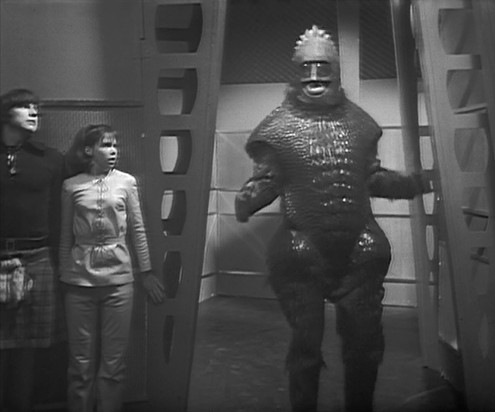The Seeds of Death v. School Reunion
This week, the Randomiser has given me - for review and connection - the unlikely pairing of The Seeds of Death (written by Barry Hayles), from early 1969 in Patrick Troughton’s final season, and School Reunion (Toby Whithouse), from April 2006 in David Tennant’s first.
The Seeds of Death
It’s mid-21st Century and humanity’s greatest technological achievement, the T-Mat, is malfunctioning. In fact, everything in The Seeds of Death is knackered - the comms, the homing beacon, the thermostat dial, even the TARDIS scanner - and no-one seems able to fix anything.
It’s a plausible prophecy of the near future. Does anyone put much hope or trust in the latest great technological innovations any more? There’s a familiar hubris to the T-Mat promo watched by the Doctor, Zoe and Jamie as, out in the real world, it all starts to crumble.

The ‘Space Age’ Earth depicted in TSOD appears to be a world of 60s men in shiny boiler suits commuting to Space Work (a sort of Sunshine Desserts bossed by a robot CJ) via T-Mat, with briefcases, and blowing kisses at female colleagues.

The only two women we see (one of them Zoe, not quite of this time but still a 21st Century girl) are both more intelligent, level-headed and efficient than any of the men. I assume this is deliberate, to deepen the sense of a stuttering, failing, male-dominated technocracy.

My partner just pointed out the similarity of Zoe and Gia Kelly’s work to the critical contributions of Dorothy Vaughan, Mary Jackson and Katherine Johnson - three black women - to the NASA space programme of the early 1960s, as recently told in the book and film Hidden Figures.

I don’t find TSOD an easy watch. I think it’s more likely to appeal to children of the 60s; the modernist Dan Dare-style sci-fi, the Doctor’s companions more like grandchildren than adult friends, scary moments derived more from the seen than the unseen.

The director, Michael Ferguson, creates a futuristic feel with some interesting and intriguing choices of shot and perspective. Pleasure gained from those is diluted by the discordant, almost unbearable soundtrack. This isn’t an ideal one to watch with family in the same room.

There’s an extended corridors chase in episode 3 that I enjoyed, and the crawling through vents and hiding in corners to escape the lumbering Ice Warriors are exciting moments. I would have wanted to recreate those in my own play if I’d seen this as a kid. Good cliffhangers too.
It’s interesting to see an early adventure of the heavy-armoured, even heavier-breathing Ice Warriors. Much like the story, they look great but sound awful.

No longer able to live on Mars, their plan is to take control of a global Earth network and exploit it for their own nefarious ends. Existing staff must work for them or be disposed of. I’m sure they’re not really called ´Ice Warriors’ so we can invent a name for them. Musks?

The Musks’ eponymous seeds of death carry their own modern-day resonance, spreading through the air and attacking their victims’ ability to breathe. Those seed pods growing out of the foam are a pretty gruesomely creepy effect.

Bar a couple of madcap running around scenes, this is quite a less playful one for Troughton’s second Doctor. We also see a harsher, warrior side to his character, killing off a few Musks without a sign of remorse. I’m left with the feeling of having watched quite a dark story.

School Reunion
Unlike TSOD, School Reunion is a story I have watched a lot. It’s a crowd pleaser, from a time that the show was on a popular high and brought Old Who and New Who together in unprecedented fashion. The people that I love were all loving DW at this point so it feels extra-special.

I guess it has staled a little, through overfamiliarity, but there are still scenes that bring a smile. Sarah’s reunion with the Doctor is a goosebumps moment, although he’s an arse about it - why frighten her like that, then lay all the ‘Everybody died’ mopey schtick on her?

Billie Piper is good in this story. Rose is thoroughly pissed off with everyone, and she plays it well both for laughs and sympathy. That furious expression when Mickey joins the TARDIS crew at the end - sometimes it’s important not to have to share something really special …
… Unless it’s with somebody you love. Which speaks to Rose’s relationship with Mickey, and also to why this story and others from this era mean so much to me. For the first time I was able to share and enjoy one of my deepest, lifelong passions with my children and my soulmate.

SR scores a hard fail on the Bechdel test, unfortunately. I don’t think there’s a single conversation between Sarah and Rose that isn’t concerned with their relationships with the Doctor. A huge and, frankly, unnecessary ego boost for the big lad.

I’m not sure I buy the suggestion that Sarah ever had romantic feelings for the Doctor anyway. That ‘There was this one guy’ line … It doesn’t ring true for me - but we can all have our own interpretations of what is unsaid or shown I guess.

Watching it all again, plus Sarah’s original departure in The Hand of Fear, I’m reminded of the mirrored endings. The TARDIS disappears and Sarah is left alone with a canine and a K9. That was nicely done.
Moving from matters of the heart to matters of wing and claw, Anthony Stuart Head is a great watch in SR: camp, creepy and as over the top as his performance really needed to be in a story in which the baddies were always going to play second fiddle to the headline acts.
I’m not so keen on the Krillitanes. Purely digitally-rendered monsters never look right in DW. I have a memory of getting annoyed that the Character Options toys of these creatures kept falling over - perhaps a result of not being designed as a costume for a real person to wear.

‘Pain and loss, they define us as much as happiness or love. Whether it’s a world or a relationship. Everything has its time. And everything ends.’ I’ve always thought that’s a great, important speech by Sarah. (Of course, it’s not strictly true in the Whoniverse.)

SR wasn’t the last we saw of Sarah Jane Smith, nor that she saw of the Doctor. Sarah has had many more on-screen adventures, and most recently been played on audio by Lis’ daughter Sadie Miller. Tennant’s Doctor journey is also yet to end.
Doctor Who never really lets go, and neither do Doctor Who fans. Till we meet again, Sarah.

Connections
Finding connections between School Reunion and either of last week’s stories (The Caretaker and Planet of Evil) wouldn’t have been too difficult, but School Reunion and The Seeds of Death? These two smell very different from each other. Like bubble bath and chip fat.
Eldred’s anger at having been abandoned by his oldest friend Radnor is echoed by Sarah’s rage at the Doctor. ‘I waited for you, you didn’t come back.’ Both accused offer unconvincing excuses. Sometimes you just decide to move on from a relationship. Own it.
The prodigious intelligence of youth plays an important role in each story. Zoe’s rare abilities allow her to co-pilot a rocket to the moon, while the schoolchildren (and Rose) gain chip fat-enhanced supercomputing powers.
In contrast, it’s a more dispiriting story for hunky dullards Jamie and Mickey, both of whom are forced to question their usefulness to the team.
Mickey does know how to pull out a plug, though. As does moonbase technician Phipps. Both avert certain disaster.
The Doctor’s still fond of messing about with wires after all these years.
Both stories feature dramatic shots of the moon. It’s more relevant to the story in TSOD, but still looks very nice in SR. This is all before it was revealed to be just a big dragon egg.
Finally, both TSOD and SR include memorable scenes of self-sacrifice. Fewsham finally found his nerve and stood up to Ice Lord Slaar, knowing he had nothing to return home to Earth for, and K9 perished as he destroyed the Krillitanes. He was a good boy.
But he probably knew he’d be back.































































Comments